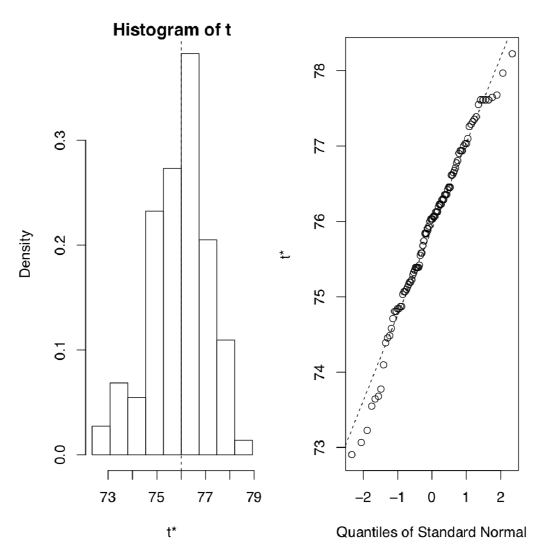1.6.9.3.3: R and Bootstrapping
( \newcommand{\kernel}{\mathrm{null}\,}\)
All generalities like standard deviation and mean are normally taken from sample but meant to represent the whole statistical population. Therefore, it is possible that these estimations could be seriously wrong. Statistical techniques like bootstrapping were designed to minimize the risk of these errors. Bootstrap is based only on the given sample but try to estimate the whole population.
The idea of bootstrap was inspired by from Buerger and Raspe “Baron Munchausen’s miraculous adventures”, where the main character pulls himself (along with his horse) out of a swamp by his hair (Figure
 Figure
Figure First, we will bootstrap the mean (Figure
Code
(Note that here and in many other places in this book number of replicates is 100. For the working purposes, however, we recommend it to be at least 1,000.)
Code
Package boot allows to calculate the 95% confidence interval:
Code
More basic bootstrap package bootstraps in a simpler way. To demonstrate, we will use the spur.txt data file. This data is a result of measurements of spur length on 1511 Dactylorhiza orchid flowers. The length of spur is important because only pollinators with mouth parts comparable to spur length can successfully pollinate these flowers.
Code
 Figure
Figure Jackknife is similar to the bootstrap but in that case observations will be taking out of the sample one by one without replacement:
Code
This is possible to bootstrap standard deviation and mean of this data even without any extra package, with for cycle and sample():
Code
(Alternatively, tt could be an empty data frame, but this way takes more computer time which is important for bootstrap. What we did above, is the pre-allocation, useful way to save time and memory.)
Actually, spur length distribution does not follow the normal law (check it yourself). It is better then to estimate median and median absolute deviation (instead of mean and standard deviation), or median and 95% range:
Code
(Note the use of replicate() function, this is another member of apply() family.)
This approach allows also to bootstrap almost any measures. Let us, for example, bootstrap 95% confidence interval for Lyubishchev’s K:
Code
Bootstrap and jackknife are related with numerous resampling techniques. There are multiple R packages (like coin) providing resampling tests and related procedures:
Code
Bootstrap is also widely used in the machine learning. Above there was an example of Jclust() function from the asmisc.r set. There also are BootA(), BootRF() and BootKNN() to boorstrap non-supervised and supervised results.
) plants. Use bootstrap and resampling methods.


